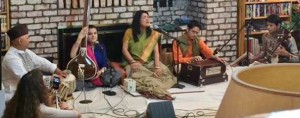By Seema Chaubey, Irwin, PA
e-mail: Â seemachaubey@hotmail.com
Note: Seema Chaubey is from Kolkata, India She learned Hindustani music from Ashim Mitra and the late Sachin Das Motilal in Kolkata. She is a music lover and resides in Irwin, PA with her family.
On November 15, 2014, Chhandayan, the Pittsburgh-based organization dedicated to Hindustani music, presented their third and last house concert of 2014 at Samar and Mala Saha’s home in Irwin, PA with nearly fifty people in the audience. The star of the evening was the notable vocalist Padma Sri Rita Ganguly (Rita-di for her admirers), accompanied by Pandit Samir Chatterji on the tabla and the young and talented Amir Khan on the sarangi. Pittsburgh’s Ayan Sinha provided harmonium support and Ganguly’s daughter Meghna Kothari was on the tanpura and provided vocal support. The picture below shows the ensemble of the artistes.
 Before Rita took the stage, the musical program began with Amie Maciszewski’s short and sweet sitar recital. She is from Dallas, Texas and was trained by sitarist Suresh Misra and Grammy winner Ustad Asish Khan. She began with raga Puriya Dhaneshwari, a twilight melody and unfolded the raga in the traditional manner of three movements – a leisurely Alap, followed by the slow Vilambit Gat, ending in a climax in Drut Gat. She ended her recital with a shorter piece in Misra Todi. Pittsburgh’s Asish Sinha provided percussion support on the tabla, ably responding to the sitarist’s Drut Laya Bols with his Paltas.
Before Rita took the stage, the musical program began with Amie Maciszewski’s short and sweet sitar recital. She is from Dallas, Texas and was trained by sitarist Suresh Misra and Grammy winner Ustad Asish Khan. She began with raga Puriya Dhaneshwari, a twilight melody and unfolded the raga in the traditional manner of three movements – a leisurely Alap, followed by the slow Vilambit Gat, ending in a climax in Drut Gat. She ended her recital with a shorter piece in Misra Todi. Pittsburgh’s Asish Sinha provided percussion support on the tabla, ably responding to the sitarist’s Drut Laya Bols with his Paltas.
Ganguly took the stage starting with Mere Shyam Na Aye, a bol Banao Alap in Raga Jhinjhinoti and Jat Tal, a short piece on the yearning of one’s soul for the spiritual love of Shyam. Her next number Hamri Atariyape Aayo Sanwaraia was a traditional Thumri in Sindhu Bhairav, a musical composition of her guru Begum Akhtar using Gulzar’s lyrics. Ganguly’s deep, husky and richly-timbered voice and the momentary split in her voice, called “Patti,†reminded the older members of the audience of Begum Akhtar.
Her next piece Koyelia Mat Kar Pukar, a familiar Dadra, immortalized by Begum Akhtar, made the audience hum and sway to the melody. Next was Mere Humnafas Mere Humnawa, a Shakel Badayuni’s ghazal in raga Darbari, which translates to “It may or may not work, but you do not refrain from beseeching the object of your love, who has showed signs of wavering, not to betray you.â€Â Ghazals bring out the finer nuances of true love, and the Sufi system of seeing the Creator as one’s lover elevates the romance in the song to a higher level. Although many of us were not well-acquainted with Urdu, the performer’s explanation and the mesmerizing rendition took us to that higher plane.
Rita next moved into a new genre of her own called Jibanmukhi, similar to the Urdu Nazm. She presented three poems of Bengali poets Shakti Chattopadhyaya and Shankha Ghosh and interpreting them with music in the tradition of the Nazm.
Rita continued with a couple more ghazals before concluding her recital with the ever-familiar and much-requested Aye Mohabbat Tere Anjaam Pe Rona Aya, a Shakeel Badayuni’s Ghazal in Bhairavi.
All through Ganguly’s recital, Samir-ji’s tabla was telling a story of its own, on how tabla can open up the flood gate of emotions hidden in Hindustani semi-classical compositions.
The young and very talented Amir Khan’s accompaniment on sarangi was haunting and melodious, keeping in tune with the songs of Rita Ganguly.
Samar Saha, the host, welcomed the artists and offered the concluding remarks before serving a delicious buffet-style dinner. Â End
